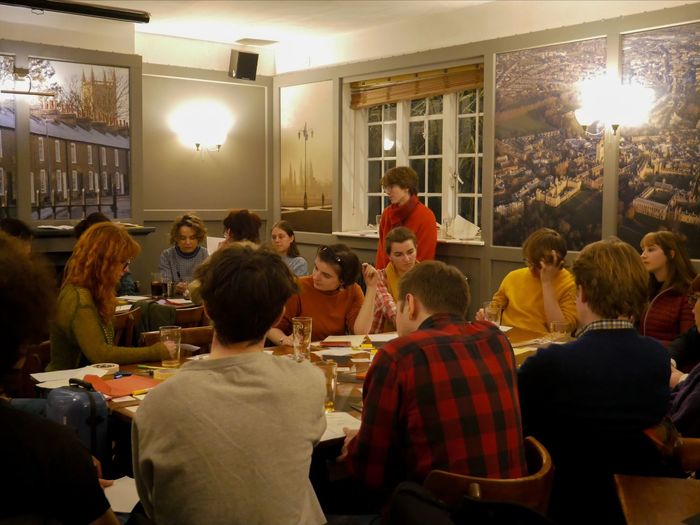Piecemeal in focus, flawless in execution
Joe Short speaks to Ahana Banerji about the publication of her debut poetry pamphlet

The city of Cambridge is held in deservedly high esteem for its contributions to culture and heritage across the board; the wealth of literature, art, landscape and architecture you encounter on the walk to Mainsbury’s for some mindless browsing speaks for itself. That said, certain loci of creativity stand out. Ahana Banerji’s debut poetry pamphlet, Piecemeal, is, in my view, one of these standouts. An ambitious poetic project, nesting in the intriguing focal niche of the microscopic, Banerji’s unique voice pays “careful attention to parts of the whole” It’s also a collection which comfortably and skilfully navigates vastly different aspects of form and theme, producing a genuinely transporting, moving corpus. It was my pleasure to speak to Banerji, both about her recent publication, and to reflect on the unique lifestyle of the student poet.
“Banerji identifies herself at her most confident when not constrained by representing literary ‘truth’, whatever that means”
In describing the process of Piecemeal’s composition, Banerji is characteristically modest. Published in conjunction with Nine Pens Press, this pamphlet marks the evolution of Banerji’s writing from the age of 14 to now. As editor and writer, whittling down sprawling free-writes to contained stanzas for publication, she talked about her pleasure in “wielding the red pen” — central to Banerji throughout Piecemeal was the creation of a cohesive and recognisable “poetic persona.”
Part of that writing exercise also involved a kind of “ventriloquizing” of literary influence — figures of inspiration crop up throughout Piecemeal, with echoes of Allen Ginsberg, Nina Simone, Edna St. Vincent Millay and Zadie Smith being just a few of the figures that create a perfect critical and intertextual storm. Banerji is also keen to stress how this rich conversationality feeds into her body of work — recalling Dickinson’s ‘Tell all the truth but tell it slant’, Banerji identifies herself at her most confident when not constrained by representing literary “truth”, whatever that means.
“Perhaps what strikes me most about Banerji, both in conversation and on the page, is the ardour of that sincerity”
Mary Oliver’s 1999 Winter Hours aptly describes the experience of reading Piecemeal — according to Oliver, the poet’s objective is to achieve a genuine body of work and a sincere energy. Perhaps what strikes me most about Banerji, both in conversation and on the page, is the ardour of that sincerity. It’s exciting. Piecemeal’s contexts of composition also speak to that earnestness: ‘Imitations at the Ashmolean’ in particular engenders a kind of transportative glee, with Banerji’s memories of being “let loose while on a writer’s programme” something you can palpably feel from the page. It’s also a moment of pause, and a site of wicked humour in a collection which, Banerji argues, draws from “desperation as its emotional centre.” Banerji also identifies with a kind of “freedom in other objects of perception”, able to wittily comment on the particulars of Bonnard’s late interiors or set out her beautiful prose analysis of Laurencin, reflecting that “some are only built to hold themselves”; art and the visual world are Banerji in her element. When asking Banerji about her own presence within the pamphlet, she’s characteristically articulate and nuanced — while “maybe some of these poems are about [her]”, Banerji rightly reserves the right to assert they are “anything but”. Piecemeal is perhaps particularly rewarding in what it reveals and engenders around truth, and that takes many forms ー the pamphlet’s personal resonance can be felt regardless of interpretation, either with a bent towards the ‘within’ or the ‘without’ of Banerji’s authorial bearing.
Another area of particular interest was the pamphlet’s manipulation of form. There’s some of the haiku-esque, the villanelle, more marshalled tercets and stanzas; Banerji identifies with a “deep interest in the aesthetics of form” and how that impacts both the experience of reading and composing. Remember, this pamphlet is five years in the making, so nods to Allen Ginsberg’s ‘Howl’ and Banerji’s beautiful Lorca-inspired work are made all the more impressive in the process of accumulation and revision. Banerji provides one example: ‘Devotional Poem’ was originally a sprawling “10 tercets”, in its current form a pithy and fragmentary experiment.
So what about next steps? Banerji admits she’s been “overwhelmed by the support she’s received” for the pamphlet, and feels perhaps just a tad perceived, but there’s also a settled sense of completion in the visual representation of a poetic voice over five years in the making. She is also understandably keen to pivot from the editing and refinement that have characterised Piecemeal’s publication ー interested readers can hope for short stories and, (you guessed it), more poems to come.
If Piecemeal is the stepping stone to a continually varied and enriching poetic trajectory for Banerji, which I have a sneaking suspicion it is, then it’s a rock-solid one.
Piecemeal is available to order via the Nine Pens Press website.
 Comment / Plastic pubs: the problem with Cambridge alehouses 5 January 2026
Comment / Plastic pubs: the problem with Cambridge alehouses 5 January 2026 News / New movement ‘Cambridge is Chopped’ launched to fight against hate crime7 January 2026
News / New movement ‘Cambridge is Chopped’ launched to fight against hate crime7 January 2026 News / Uni-linked firms rank among Cambridgeshire’s largest7 January 2026
News / Uni-linked firms rank among Cambridgeshire’s largest7 January 2026 News / Cambridge businesses concerned infrastructure delays will hurt growth5 January 2026
News / Cambridge businesses concerned infrastructure delays will hurt growth5 January 2026 Features / Who gets to speak at the Cambridge Union?6 January 2026
Features / Who gets to speak at the Cambridge Union?6 January 2026










